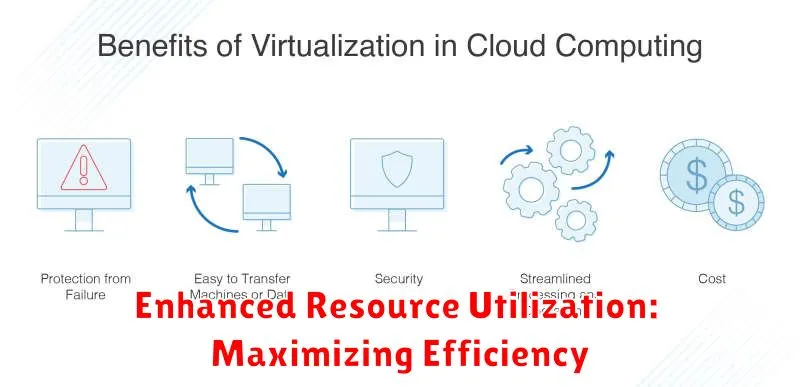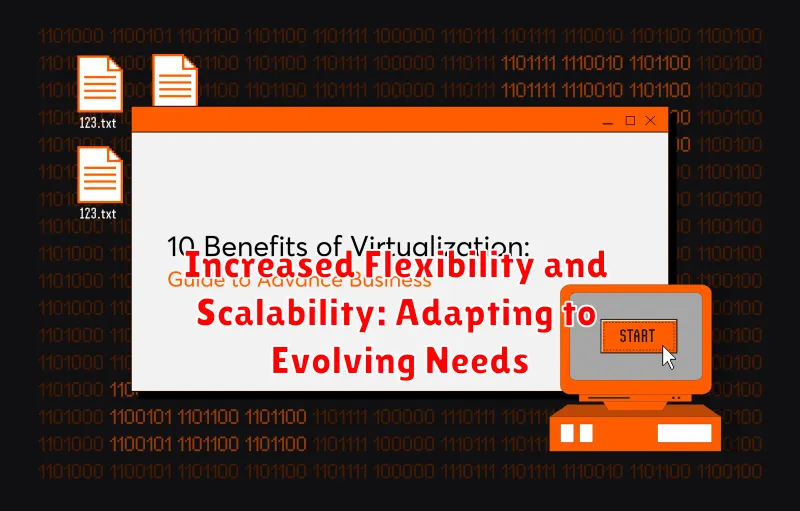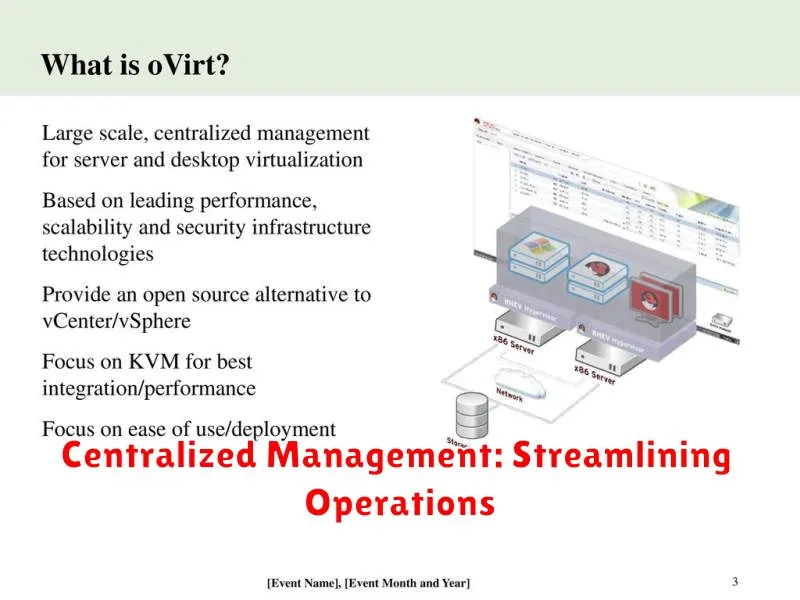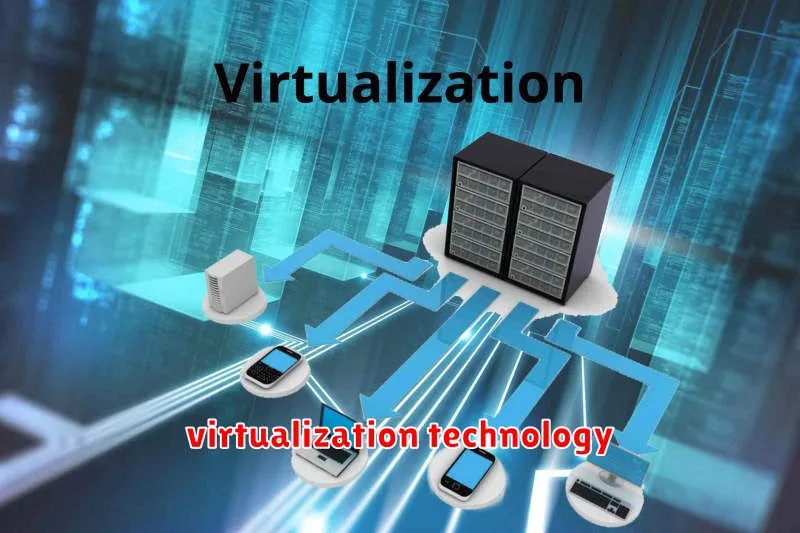In today’s fast-paced and ever-evolving business landscape, adaptability and agility are paramount to success. Companies are constantly seeking ways to optimize their operations, enhance efficiency, and gain a competitive edge. One powerful tool that can significantly contribute to this quest is virtualization technology. By leveraging the power of virtualization, organizations can unlock new levels of flexibility and efficiency, paving the way for accelerated growth and innovation.
This article delves into the transformative benefits of virtualization technology, exploring how it empowers businesses to adapt to changing market dynamics, optimize resource utilization, and ultimately, achieve greater agility. We will uncover the key advantages of virtualization, including cost reduction, improved performance, enhanced scalability, and increased security, providing valuable insights into how this technology can revolutionize your business operations.
Understanding Virtualization: A Primer

Virtualization is a technology that allows you to create virtual versions of physical resources, such as servers, storage, and networks. This means you can run multiple operating systems and applications on a single physical machine, as if they were each running on their own dedicated hardware.
Think of it like this: Imagine a single computer that can host multiple virtual machines, each acting like an independent computer with its own operating system and applications. The virtual machines are separated from the physical hardware, but they can still access and utilize the resources of the physical machine.
There are several types of virtualization, but the most common are:
- Server Virtualization: This is the most common type of virtualization, where multiple virtual servers run on a single physical server.
- Desktop Virtualization: This allows users to access their desktops and applications from any device, regardless of their physical location.
- Network Virtualization: This virtualizes network components, such as routers and switches, making them more flexible and easier to manage.
Virtualization offers a wide range of benefits for businesses, including:
- Cost Savings: Virtualization reduces hardware costs by allowing multiple workloads to run on a single physical machine.
- Increased Efficiency: Virtualization simplifies server management and allows for faster deployment of new applications.
- Improved Flexibility: Virtualization makes it easier to scale resources up or down as needed, and to quickly adapt to changing business needs.
- Enhanced Security: Virtualization can help isolate applications and data, making them less vulnerable to security threats.
Virtualization is a powerful technology that can help businesses improve their agility and efficiency. By understanding the basics of virtualization, you can start to explore how it can benefit your organization.
Enhanced Resource Utilization: Maximizing Efficiency

Virtualization technology plays a pivotal role in driving business agility by optimizing resource utilization. This transformative approach enables organizations to maximize the efficiency of their physical infrastructure, leading to significant cost savings and enhanced performance.
By consolidating multiple virtual machines onto a single physical server, virtualization eliminates the need for dedicated hardware for each application. This consolidation effectively reduces hardware costs, energy consumption, and the overall footprint of the data center. Furthermore, virtualization allows for dynamic allocation of resources, ensuring that applications receive the exact amount of computing power they require, eliminating overprovisioning and resource wastage.
The ability to quickly provision and deploy virtual machines on demand empowers businesses to rapidly respond to changing market conditions. This agility translates into faster time-to-market for new products and services, allowing businesses to seize opportunities and stay ahead of the competition. Additionally, virtualization facilitates seamless scalability, enabling organizations to effortlessly scale their infrastructure up or down to meet fluctuating demand.
In conclusion, virtualization technology significantly enhances resource utilization by optimizing physical infrastructure, reducing hardware costs, and enabling dynamic allocation. This efficiency translates into a range of benefits for businesses, including cost savings, improved performance, and enhanced agility. By embracing virtualization, organizations can unlock their full potential and achieve unprecedented levels of operational excellence.
Cost Savings: Reducing Hardware and Operational Expenses

Virtualization is a game-changer for businesses seeking to optimize resource utilization and slash operational expenses. By consolidating multiple physical servers onto a single, shared platform, organizations can significantly reduce their hardware footprint. This translates to lower acquisition costs, reduced energy consumption, and minimized maintenance overhead.
The reduction in hardware investment is a direct result of server consolidation. With virtualization, businesses can run multiple virtual machines (VMs) on a single physical server, eliminating the need for separate hardware for each application. This leads to a significant reduction in capital expenditure (CAPEX) on servers, storage, and networking equipment.
Moreover, virtualization optimizes resource utilization, leading to lower operational expenses (OPEX). By sharing resources across multiple VMs, organizations can allocate computing power, memory, and storage more efficiently. This reduces the need for overprovisioning, minimizing energy consumption and cooling requirements, ultimately translating into substantial cost savings on utilities.
Furthermore, the centralized management capabilities of virtualization platforms simplify administration and maintenance tasks. With a single console to manage multiple VMs, businesses can streamline operations, reduce staff workload, and minimize downtime associated with server maintenance.
In summary, virtualization offers tangible cost savings by reducing hardware investments and operational expenses. By consolidating servers, optimizing resource utilization, and simplifying management, businesses can achieve a leaner infrastructure, lower energy consumption, and a more agile IT environment. These cost savings can be reinvested in strategic initiatives, fostering business growth and innovation.
Increased Flexibility and Scalability: Adapting to Evolving Needs

Virtualization empowers businesses with increased flexibility and scalability, allowing them to adapt to dynamic market conditions and evolving business needs. This adaptability stems from virtualization’s ability to decouple software from physical hardware, creating a more agile and responsive IT infrastructure.
Virtualization enables businesses to quickly provision new resources, scale up or down their infrastructure on demand, and seamlessly migrate applications and workloads between different physical servers. This agility translates to faster response times, improved resource utilization, and reduced downtime, ultimately enhancing operational efficiency and business agility.
In a world characterized by rapid technological advancements and unpredictable market trends, virtualization empowers businesses to stay ahead of the curve by enabling them to respond quickly to emerging opportunities, adapt to changing customer demands, and seize competitive advantages.
Simplified Disaster Recovery: Ensuring Business Continuity

In today’s fast-paced digital landscape, businesses are increasingly reliant on technology. This reliance, however, comes with the risk of disruptions caused by natural disasters, cyberattacks, or technical failures. To mitigate these risks and ensure business continuity, organizations must adopt robust disaster recovery plans. Virtualization technology plays a crucial role in simplifying disaster recovery processes and enhancing business resilience.
Virtualization allows organizations to create virtual copies of their physical servers, applications, and data. These virtual machines can be easily replicated and stored in a separate location, such as a cloud environment. This creates a readily accessible backup that can be quickly deployed in the event of a disaster. By leveraging virtualization, organizations can significantly reduce downtime and minimize the impact of disruptions on their operations.
Furthermore, virtualization simplifies the disaster recovery process by enabling rapid provisioning of resources. Instead of physically rebuilding infrastructure, organizations can simply spin up virtual machines from their backups. This agile approach dramatically accelerates the recovery process, minimizing downtime and ensuring business continuity.
The ability to easily replicate and store virtual machines in different locations also enhances business resilience. By deploying virtualized workloads in geographically diverse locations, organizations can ensure business continuity even if one location is affected by a disaster. This approach provides a robust disaster recovery strategy that minimizes risk and protects critical business operations.
In conclusion, virtualization technology simplifies disaster recovery processes and empowers organizations to achieve business continuity in the face of disruptions. By embracing virtualization, businesses can reduce downtime, minimize financial losses, and maintain a competitive edge in an increasingly uncertain world.
Improved Security: Strengthening Your IT Infrastructure

Virtualization technology offers significant benefits for businesses, including improved security. By consolidating physical servers into virtual machines, virtualization helps to reduce the attack surface and enhance overall security posture.
One key advantage is centralized management. With all virtual machines running on a single physical server, security policies and updates can be applied centrally, simplifying management and reducing potential vulnerabilities. This also allows for easier patch management, ensuring that all systems are up-to-date with the latest security patches.
Another crucial benefit is enhanced isolation. Virtualization environments create isolated sandboxes for virtual machines, preventing malicious software from spreading between them. This isolation helps contain breaches and minimizes the impact of attacks.
Furthermore, virtualization technology enables stronger security controls. Features like virtual firewalls, intrusion detection systems, and antivirus software can be easily implemented and managed within a virtualized environment. These controls can help detect and prevent unauthorized access and malicious activities.
In conclusion, virtualization plays a vital role in strengthening IT infrastructure security. By centralizing management, enhancing isolation, and providing strong security controls, virtualization helps organizations mitigate risks, protect critical data, and improve overall security posture. Embracing virtualization technology can be a strategic move towards achieving a robust and secure IT environment.
Centralized Management: Streamlining Operations

One of the key advantages of virtualization technology lies in its ability to centralize management, a process that significantly streamlines operations. By consolidating physical infrastructure into a virtual environment, organizations gain a unified platform to manage various aspects of their IT ecosystem, from servers and storage to applications and networks.
This centralized approach simplifies tasks that were once complex and dispersed. Instead of dealing with multiple physical machines, administrators can now manage everything from a single console. This reduces administrative overhead, freeing up valuable time for other critical tasks.
Furthermore, centralized management enhances visibility and control over the IT environment. Organizations gain real-time insights into resource utilization, performance metrics, and potential issues. This improved transparency enables proactive monitoring and troubleshooting, minimizing downtime and ensuring smooth operations.
By consolidating resources and streamlining management, virtualization technology empowers organizations to optimize resource allocation. This allows them to scale up or down as needed, eliminating the need for expensive and underutilized physical infrastructure.
In summary, the power of centralized management through virtualization translates into improved efficiency, reduced costs, and enhanced agility. By simplifying IT operations, organizations can focus on strategic initiatives and deliver value to their customers more effectively.
Environmental Sustainability: Reducing Carbon Footprint

In the quest for a sustainable future, businesses are increasingly embracing virtualization technology as a powerful tool to reduce their carbon footprint. Virtualization, in essence, involves running multiple operating systems and applications on a single physical server. This approach optimizes resource utilization, leading to significant environmental benefits.
Reduced Energy Consumption: By consolidating multiple physical servers into fewer virtualized machines, virtualization significantly minimizes energy consumption. Fewer servers mean less power draw, resulting in reduced electricity bills and a smaller carbon footprint.
Minimized Hardware Footprint: Virtualization eliminates the need for a vast number of physical servers, leading to reduced hardware purchases and associated manufacturing emissions. This translates into less electronic waste and a more sustainable approach to technology infrastructure.
Enhanced Server Utilization: Virtualization allows for optimal utilization of server resources, maximizing performance while minimizing idle time. This efficiency reduces the need for additional servers, further contributing to reduced energy consumption and emissions.
Simplified Infrastructure Management: Virtualized environments simplify server management, allowing for streamlined operations and reduced maintenance needs. This translates into less energy expenditure on cooling and other infrastructure requirements.
By adopting virtualization, businesses can make significant strides toward achieving their sustainability goals. This technology empowers organizations to operate more efficiently, consume less energy, and contribute to a greener future. Embracing virtualization is not only a strategic business move but also a responsible step towards a more sustainable world.
Case Studies: Real-World Success with Virtualization

Virtualization technology has become a cornerstone of modern IT infrastructure, offering significant benefits in terms of efficiency, agility, and cost savings. To truly understand its impact, let’s delve into real-world case studies showcasing the transformative power of virtualization.
Case Study 1: Retail Giant Accelerates Deployment
A global retail giant faced challenges in deploying new applications quickly and efficiently. They were bogged down by physical servers, requiring long lead times for provisioning and configuration. By adopting virtualization, they dramatically improved application deployment times, reducing it from weeks to mere hours. The ability to provision virtual machines on-demand enabled them to meet rapidly changing business demands.
Case Study 2: Financial Institution Improves Disaster Recovery
A major financial institution was concerned about business continuity in the face of potential disasters. Virtualization provided a robust solution. They implemented a disaster recovery strategy based on virtual machines, ensuring that critical systems could be rapidly restored at a remote location. This dramatically reduced downtime and minimized financial losses in the event of an emergency.
Case Study 3: Healthcare Provider Enhances Patient Care
A leading healthcare provider was struggling with limited IT resources to support growing patient demand. Virtualization allowed them to consolidate their IT infrastructure, reducing hardware costs and freeing up valuable staff time. This enabled them to focus on core healthcare operations and enhance patient care by investing in new technologies and improving service delivery.
Key Takeaways
These case studies demonstrate the tangible benefits of virtualization across various industries. It has empowered organizations to:
- Accelerate application deployment
- Improve disaster recovery and business continuity
- Consolidate IT infrastructure, reducing costs and improving efficiency
- Enhance agility and responsiveness to changing business needs
As virtualization continues to evolve, organizations are increasingly reaping its rewards, paving the way for a more agile and efficient future.
Future Trends: The Evolution of Virtualization Technology

Virtualization technology has revolutionized how businesses operate, enabling them to optimize resource utilization, enhance agility, and drive innovation. As technology continues to evolve, virtualization is poised for significant advancements, shaping the future of computing and unlocking even greater business potential. Here are some key future trends driving the evolution of virtualization:
Serverless Computing: The serverless model offers a dynamic and scalable approach to virtualization, eliminating the need for traditional physical servers. This allows businesses to focus on application development and deployment without managing infrastructure. Serverless computing enables greater flexibility, cost optimization, and reduced operational overhead.
Edge Computing: As data generation and processing shift closer to users, edge computing becomes increasingly vital. Virtualization plays a crucial role in enabling edge deployments, allowing businesses to deploy and manage applications closer to the source of data. This minimizes latency, improves response times, and enhances the user experience.
Artificial Intelligence (AI) and Machine Learning (ML): AI and ML are transforming various industries, and virtualization provides a robust platform for their development and deployment. Virtualized environments offer the flexibility and scalability needed to train and execute AI and ML models efficiently. This allows businesses to harness the power of these technologies for predictive analytics, automated decision-making, and enhanced efficiency.
Hybrid and Multi-Cloud: The rise of hybrid and multi-cloud environments is driving the need for seamless virtualization across different platforms. Virtualization solutions are evolving to support interoperability and orchestration, enabling businesses to leverage the best of both on-premises and cloud infrastructure.
Containerization: Containerization has gained immense popularity, offering lightweight and portable virtualization for applications. Virtualization is playing an increasingly important role in container orchestration, providing a secure and scalable platform for managing containerized workloads.
The future of virtualization is bright, with advancements in serverless computing, edge computing, AI and ML integration, hybrid and multi-cloud adoption, and containerization transforming how businesses operate. By embracing these trends, organizations can unlock greater agility, cost savings, and innovation, paving the way for a more dynamic and efficient future.

